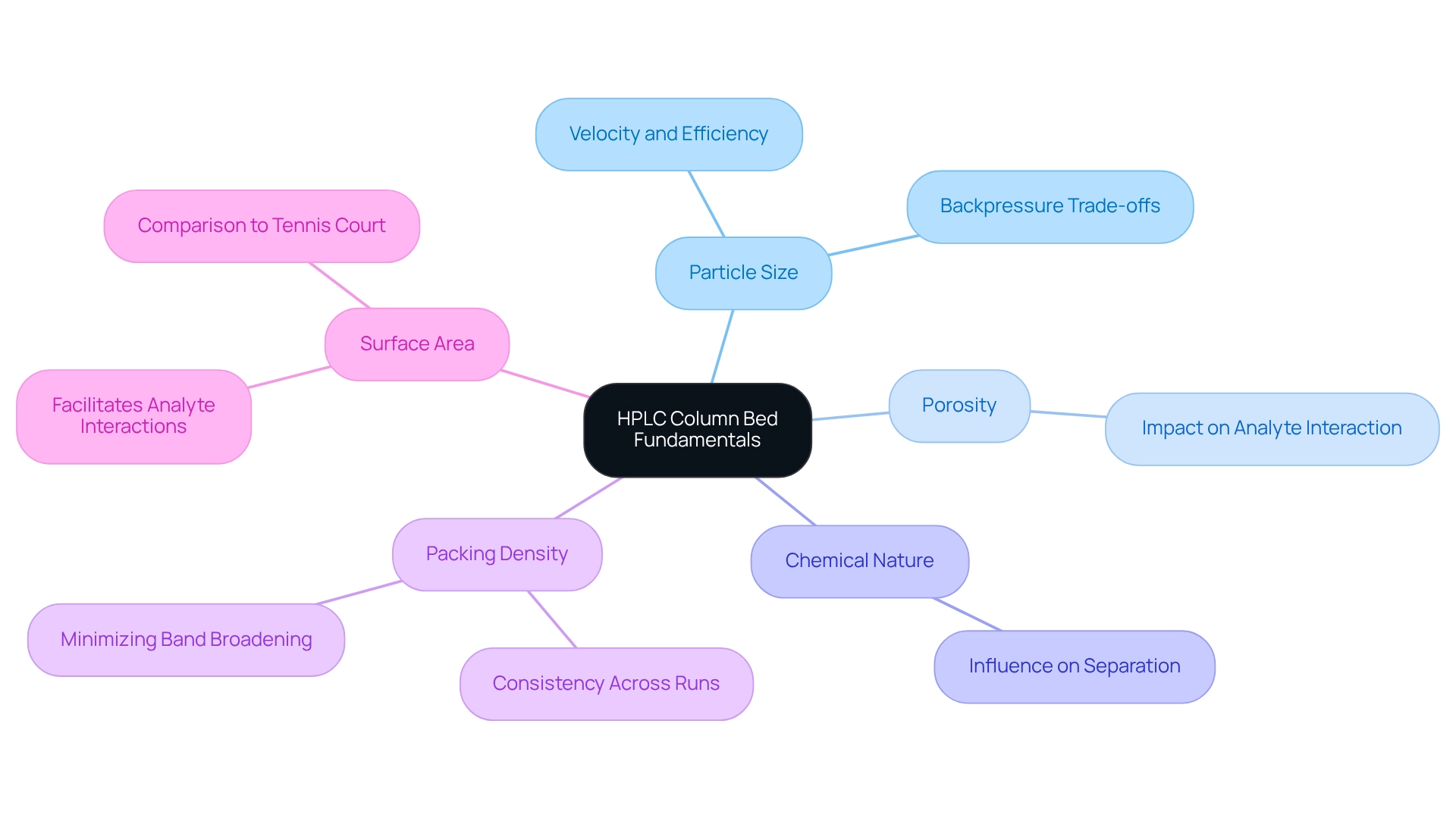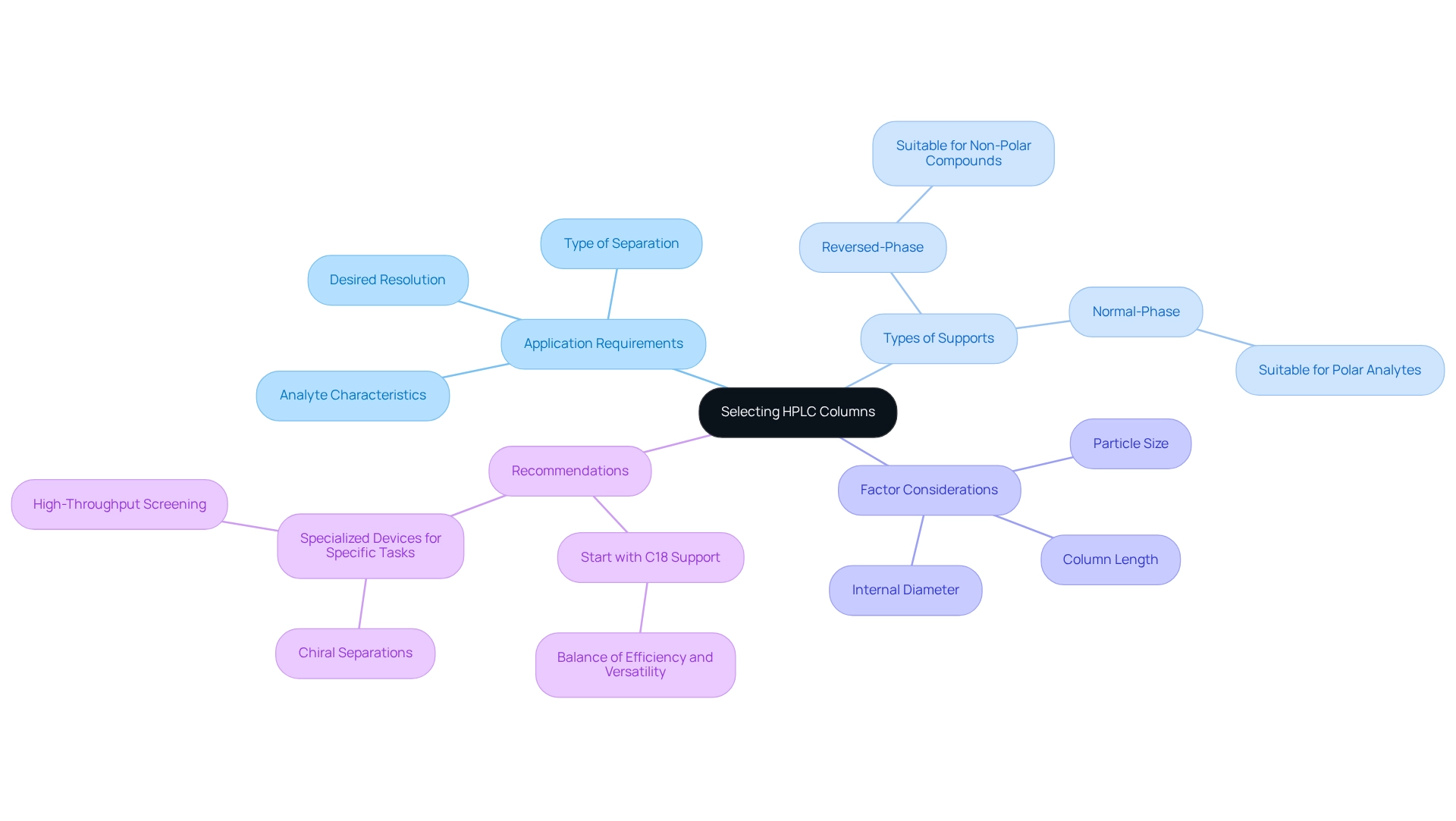Overview
The article highlights the critical importance of selecting and maintaining HPLC column beds to optimize performance in high-performance liquid chromatography applications.
Careful consideration of factors such as:
- Particle size
- Column type
- Maintenance practices
is essential, as these elements significantly enhance separation efficiency and analytical reliability.
Expert insights and compelling case studies underscore the impact of these considerations on HPLC outcomes, providing a robust foundation for understanding their importance.
Ultimately, a strategic approach to HPLC column management can lead to superior analytical results, reinforcing the need for meticulous attention to these key factors.
Introduction
In the realm of high-performance liquid chromatography (HPLC), the selection and upkeep of column beds are crucial for attaining precise and dependable analytical results. This article focuses on the fundamental principles governing column efficiency, delving into the intricacies of:
- Stationary phases
- Particle size
- Packing techniques
These factors significantly influence separation outcomes. By examining the critical factors involved in choosing the appropriate column based on specific application requirements, readers will gain valuable insights into optimizing their chromatographic processes.
Furthermore, best practices for column maintenance and usage will be highlighted, ensuring laboratories can prolong the lifespan of their equipment while sustaining peak performance. This comprehensive examination aims to equip professionals with the essential knowledge to navigate the complexities of HPLC column beds effectively.
Understand HPLC Column Bed Fundamentals
HPLC bed materials consist of stationary substances that interact with analytes during the separation process, significantly influencing the effectiveness of chromatography. Key factors such as particle size, porosity, and the chemical nature of the stationary phase are crucial in determining performance. For instance, halving the particle diameter can double the velocity and efficiency within the system, although this also results in quadrupled backpressure, underscoring the trade-offs inherent in material selection.
Smaller particles typically yield higher resolution; however, they also contribute to increased backpressure, necessitating careful consideration of instrument capabilities. The surface area of a typical high-performance liquid chromatography apparatus is comparable to that of a tennis court due to the silica employed, which highlights the importance of surface interactions in achieving separation efficiency. This expansive surface area facilitates more effective analyte interactions, a critical factor for optimal separation outcomes.
Moreover, the packing density and uniformity of the column bed are vital for achieving consistent results across analytical runs. Well-packed structures minimize band broadening, thereby enhancing separation efficiency, which is essential for high-performance liquid chromatography applications. As Richard A. Henry aptly notes, "a lower term will arise from improved support preparation techniques and more uniform bed structures," emphasizing the importance of meticulous support preparation.
Recent advancements in HPLC technology have focused on refining packing methods and achieving more uniform column bed structures. Expert insights indicate that improved preparation techniques can lead to lower resistance and enhanced performance. Case studies, including analyses of Zhuoheng Zhou's work, underscore the importance of comparing kinetic performance with ideal and target solutes during screening. These studies also highlight the necessity for stability under high flow and pressure conditions to ensure efficient high-speed techniques, reinforcing the fundamental role of bed characteristics in optimizing liquid chromatography performance.

Select Column Beds Based on Application Requirements
When selecting an HPLC tube, it is crucial to consider the specific requirements of the application, including the characteristics of the analytes, the desired resolution, and the type of separation needed—such as normal phase, reverse phase, or size exclusion.
- Reversed-phase supports are commonly employed for non-polar compounds, while normal-phase supports are suitable for polar analytes.
- Additionally, factors like the length of the column, internal diameter, and particle size must be tailored to the specific method in use.
- A general recommendation is to begin with a C18 support for most applications, as it strikes an excellent balance between efficiency and versatility.
- However, for specialized tasks, such as chiral separations or high-throughput screening, it is imperative to choose a device specifically designed for those applications to achieve optimal outcomes.
Incorporating expert insights and relevant market data on chromatography devices can further enhance this discussion, ensuring laboratories are equipped with the necessary information for precise and reliable analyses.

Implement Best Practices for Column Bed Maintenance and Usage
To ensure optimal performance of HPLC systems, it is crucial to adhere to best practices for maintenance and usage. Regularly flushing the structure with suitable solvents prevents clogging and contamination. For a 100 mm tube, it is recommended to flush with 10 times its volume—approximately 16.6 mL—to effectively clear any residual materials. After each use, items should be stored in a solvent that prevents the stationary material from drying out, thus maintaining their integrity.
Creating a regular maintenance timetable that includes:
- Inspecting for leaks
- Observing backpressure
- Changing guard supports
can significantly prolong the durability of the main structure. Utilizing HPLC-grade solvents and filtering all mobile phases to remove particulates is advised, as these actions safeguard the apparatus from potential harm. Routine examination of chromatography tubes for indications of damage or contamination is recommended, following manufacturer instructions for diagnosis or replacement if necessary.
According to industry insights, proper vertical storage is essential for extending the lifespan of structures, underscoring the importance of careful handling and maintenance. Implementing these best practices not only enhances the efficiency of HPLC systems but also ensures the reliability of analytical results over time when utilizing a column bed. Furthermore, case studies indicate that adhering to manufacturer guidelines and optimizing mobile phase composition can lead to substantial improvements in the longevity and performance of the column bed, ultimately resulting in more accurate and consistent analytical outcomes.
Conclusion
Understanding the intricacies of HPLC column beds is paramount for achieving precise and reliable analytical results. The selection of stationary phases, consideration of particle size, and optimal packing techniques are critical factors that directly influence column efficiency and separation outcomes. By recognizing how these elements interact, laboratories can tailor their HPLC systems to meet specific application requirements, ensuring that the desired resolution and separation type are achieved effectively.
Moreover, adherence to best practices for column maintenance and usage is essential for prolonging the lifespan of these vital components. Regular flushing, careful storage, and routine inspections can prevent contamination and damage, safeguarding the integrity of the column and the accuracy of analytical results. Employing HPLC-grade solvents and following manufacturer guidelines further enhances performance and reliability.
Ultimately, mastering the fundamentals of HPLC column beds and implementing strategic maintenance practices not only optimizes chromatographic processes but also empowers professionals to navigate the complexities of high-performance liquid chromatography with confidence. By prioritizing these aspects, laboratories can sustain peak performance and achieve consistent, high-quality analytical outcomes, reinforcing the importance of meticulous column selection and care in the realm of HPLC.




